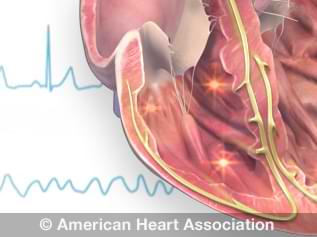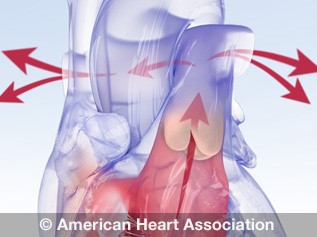What is an Arrhythmia?

The term “arrhythmia” refers to any problem in the rate or rhythm of a person’s heartbeat. During an arrhythmia, the electrical impulses may be too fast, too slow or erratic, causing an irregular heartbeat.
When the heart doesn’t beat properly, it can’t pump blood effectively. When this happens, the lungs, brain and all other organs can’t work properly and may shut down or be damaged. View an animation of arrhythmia.
Types of Arrhythmias
- Atrial Fibrillation
- Atrial Flutter
- Bradycardia
- Conduction Disorders
- Premature Contraction
- Tachycardia
- Ventricular Fibrillation
- Other Rhythm Disorders
- Types of Arrhythmias in Children
The normal heart is a strong, muscular pump about the size of a fist. It pumps blood to all parts of the body.
To understand how the heart pumps, learn about: Structure of the heart
Watch an animation of heart valve anatomy
The heart: Four chambers, four valves
The heart has four chambers, two on the right and two on the left:
- Two upper chambers are called atria (one is called an atrium).
- Two lower chambers are called ventricles.
The heart also has four valves that open and close to let blood flow in only one direction when the heart contracts (beats). The four heart valves are:
- Tricuspid valve, located between the right atrium and right ventricle
- Pulmonary or pulmonic valve, between the right ventricle and the pulmonary artery
- Mitral valve, between the left atrium and left ventricle
- Aortic valve, between the left ventricle and the aorta
Each valve has a set of flaps (also called leaflets or cusps). The mitral valve has two flaps; the others have three. Blood flow occurs only when there’s a difference in pressure across the valves, which causes them to open. Under normal conditions, the valves allow blood to flow in only one direction.
The heart pumps blood to the lungs and to all the body’s tissues by a sequence of highly organized contractions of the four chambers. For the heart to function properly, the four chambers must beat in an organized way.
Electrical system of the heart
Electrical signals control the pump
The heartbeat (contraction) begins when an electrical impulse from the sinus node (also called SA node) moves through the heart’s muscle tissue. The SA node is sometimes called the heart’s “natural pacemaker” because it starts the impulses for the heartbeat.
The normal electrical sequence begins in the right atrium and spreads throughout the atria to the atrioventricular (AV) node. Electrical impulses travel down the bundle of His from the AV node and through the Purkinje fibers, causing the ventricles to contract.
The normal heart beats in a regular manner because electrical impulses cause a sequence of organized contractions. In an adult, a normal heart beats 60 to 100 times a minute.
Electrocardiography (ECG or EKG) is a simple, painless test that records the heart’s electrical activity and can help detect arrhythmias (abnormal heart rhythms).
Abnormal heart rhythms (arrhythmias)
Arrhythmias are abnormal heartbeats. The term “arrhythmia” refers to any change from the normal sequence of electrical impulses.
Some arrhythmias are so brief (such as a temporary pause or premature beat) that the overall heart rate or rhythm isn’t greatly affected. But if arrhythmias last longer, they may make the heart rate too slow, too fast or erratic, so the heart pumps less effectively.
- A fast heart rate (in adults, more than 100 beats per minute) is called tachycardia.
- A slow heart rate (less than 60 beats per minute) is called bradycardia.
Causes
Normally, the heart’s most rapidly firing cells are in the sinus node, making that area a natural pacemaker. Under some conditions, almost all heart tissue can start an impulse of the type that can generate a heartbeat.
- Cells in the heart’s conduction system can fire automatically and start electrical activity. This activity can interrupt the normal order of the heart’s pumping activity.
- Secondary pacemakers elsewhere in the heart provide a “backup” rhythm when the sinus node doesn’t work properly or when impulses are blocked somewhere in the conduction system.
Arrhythmias can be caused by:
- A delay or blockage of the electrical signals that control the heartbeat
- Another part of the heart taking over as pacemaker
- Changes to heart tissue caused by changes in blood flow, damage to the heart’s electrical system or stiffening or scarring of the heart tissue
- Excessive exertion, strain or stress
- An imbalance of fluids, hormones or electrolytes in the blood
- Certain heart medications
An arrhythmia occurs when:
- The heart’s natural pacemaker develops an abnormal rate or rhythm.
- The normal conduction pathway is interrupted or changed.
- Another part of the heart takes over as a pacemaker.








